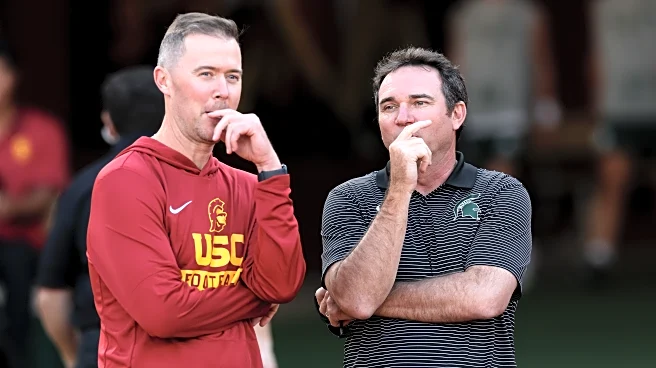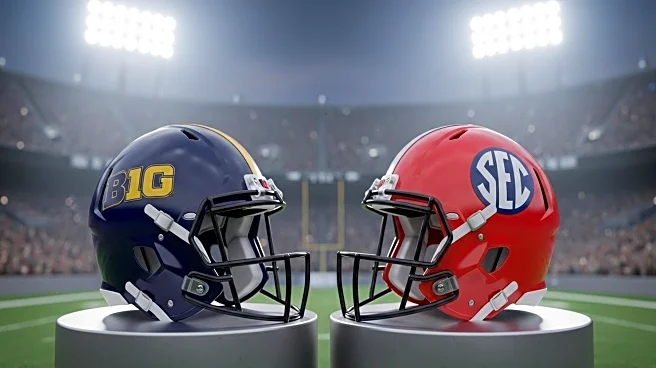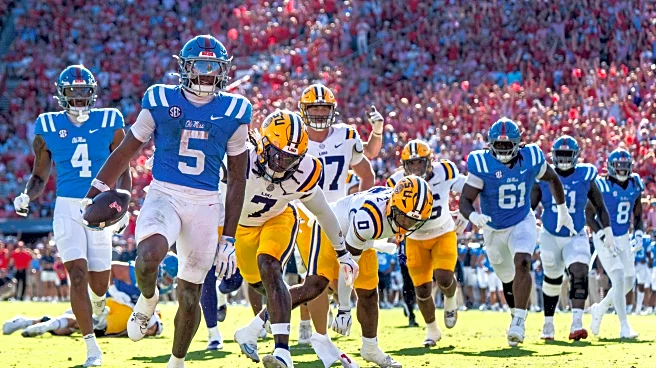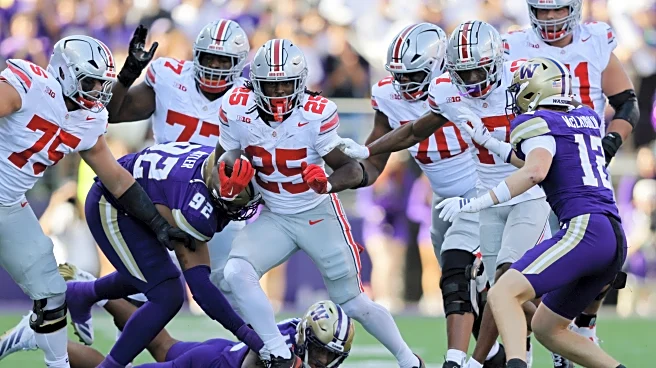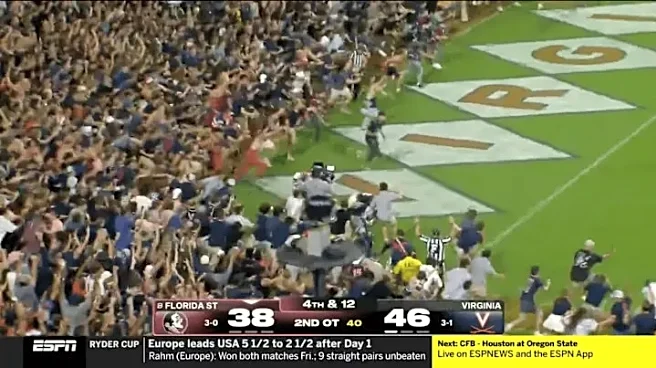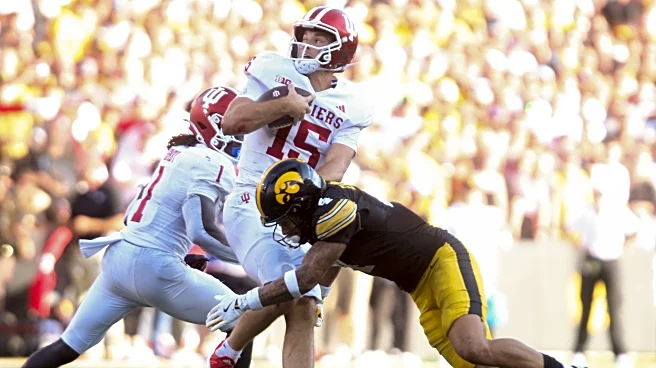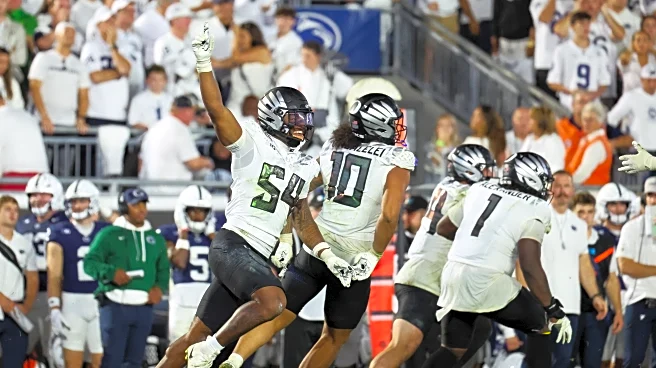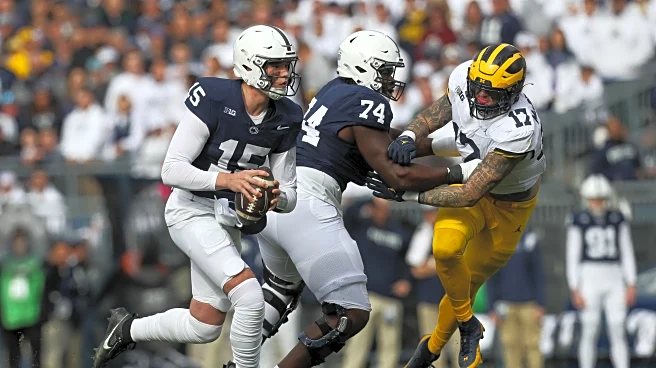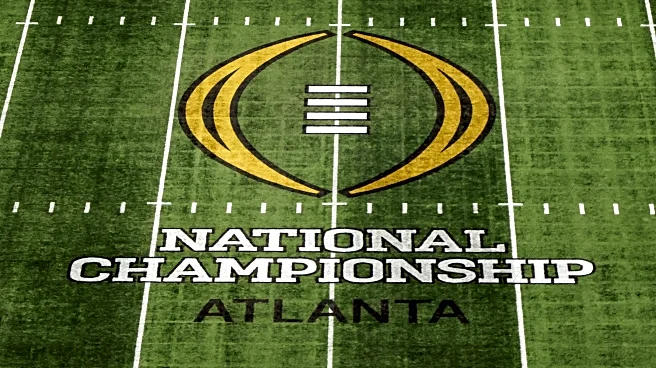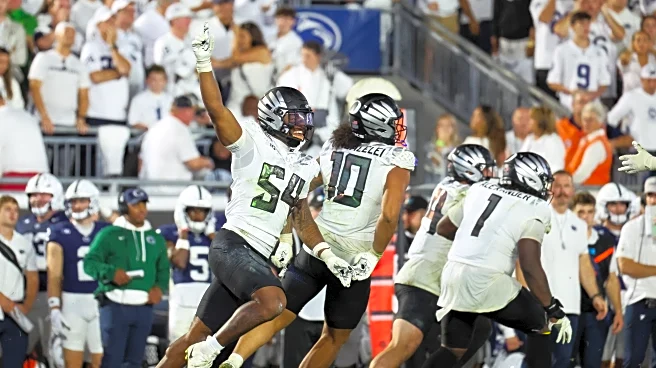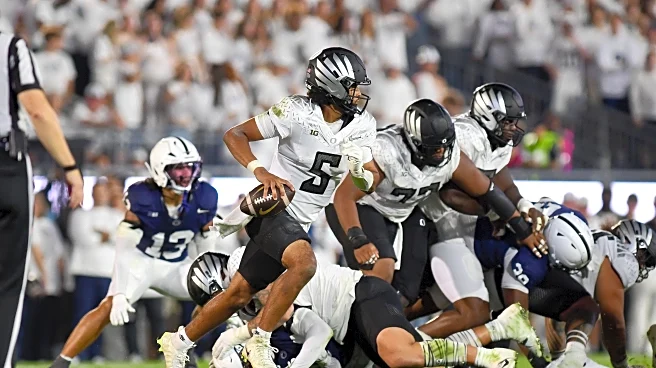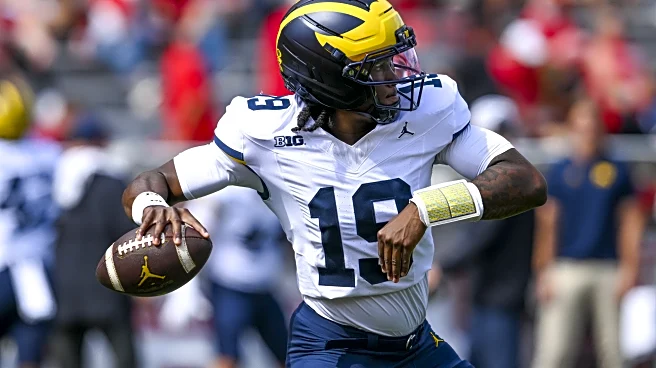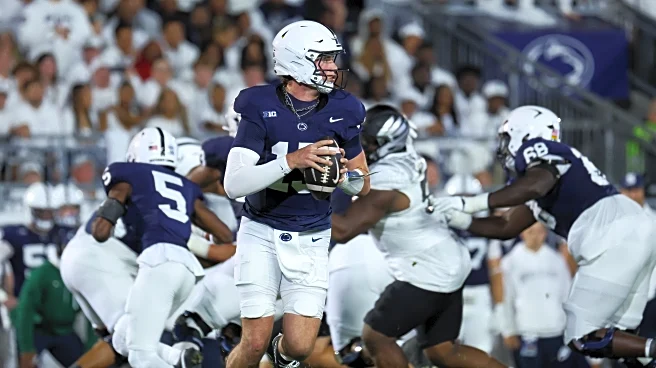Welcome back from the bye! While the Spartans enjoyed a weekend off, several big time games with serious College Football Playoff implications kicked off last Saturday. In today’s Film Room, we will take advantage of MSU’s bye to take a look around the nation at a couple huge plays that defined games, along with a quick preview of what to expect from this Saturday’s opponent: the Nebraska Cornhuskers. Enjoy.
Oregon @ Penn State
Let’s kick things off here in the Big Ten. A rowdy whiteout crowd and 4th
quarter comeback were not enough for James Franklin to get his much needed signature win versus a top 10 opponent.
Thanks to an impressively poised and mature game from inexperienced QB Dante Moore (who was formerly a recruiting target of MSU under Mel Tucker) and the Oregon offense despite the hostile environment, Penn State found itself in an overtime showdown.
After matching one another in the first overtime, Oregon received the first possession in 2OT, and promptly scored on a 25 yard strike from the Detroit-native Moore to Gary Bryant Jr.. Below is the very next play. Penn State starts its’ second OT possession lined up in an “FIB” or “Formation into Boundary” set.

Offensive coordinators most commonly utilize FIB formations to gain an advantage in one of two ways: firstly, to see if the defense will set their “strength” to the short side of the field, and bring their strong side outside linebacker and/or strong safety to the boundary side. If they do not, and keep these overhang players on the wide field side, you will more often than not see a quick screen pass or outside run to the boundary, attempting to take advantage of the numbers advantage gained. If you can think back to the Dantonio days, former Offensive Coordinators Dave Warner and Jim Bollman both loved to use FIB concepts to set up jet sweeps to the likes of Macgarret Kings Jr. and RJ Shelton towards the short side of the field, which saw varying success.
But what if the defense does set their strength to the boundary? Well, this usually gives offenses beneficial 1on1 matchups with their outside WR to the wide field side, commonly with cornerbacks playing well off of the ball, giving a large cushion because of the large area he is now responsible for. We have seen Michigan State OC Brian Lindgren use FIB a handful of times this season already, often to isolate one defender on Nick Marsh to the field, and get the ball in his hands quickly on hitch or quick out routes (think, Youngstown State first half).
Overall, there are a variety of other reasons to utilize FIB sets, but giving coordinators the simple pre-snap read of finding where the defense has set its strength to makes determining the right type play to call much simpler. Now, back to Penn State.

The Nittany Lions have a creative wrinkle in the works for 2OT. Above, I have drawn up the pre-snap “return” motion by the outside-most PSU WR, and ensuing reaction by the Oregon defense. #8, Trebor Peña, uses his speed to motion from the boundary to the field, before hitting the breaks and turning around. The motion gets him in the perfect position to fake a jet sweep to the boundary (which, as you now know, is a classic FIB play). It also forces communication amongst the Oregon Duck defenders. Watch the back end of the defense effectively identify the motion, and promptly adjust to their right, towards the field. Since no one follows Peña immediately after his motion, Penn State QB Drew Allar likely diagnoses some sort of a zone coverage. Here is a clip of only the motion and reaction below:

Now to the entire play. Below is a diagram of how Penn State is planning to fake the jet sweep; by using both the running back in the backfield and Tight End in a wing to pretend to block for the sweep, before each of them will release into vertical routes. The now-furthest-outside WR will be running a “clearout” vertical- taking the cornerback out of position to make a play on either the TE or RB. Notice #31 for Oregon- outlined with a red triangle.

Watch below as upon the snap, the boundary corner bails with the clearout, just as planned. The boundary safety is delayed just enough by the fake. And even #31, Dillon Thieneman, bites hard on the jet sweep action, just as Drew Allar and Penn State had hoped. In practice all week long, my bet is that whenever the defense reacted like so, Allar was able to fit a ball to the Tight End, #85 in the window between defenders. However, late Saturday night, this was not the case. Watch the false hand-off, the setup as if #85 was a blocker, and the window open as Thieneman crashes downhill following the motion fake. And of course, watch how Thieneman was able to recover in the nick of time to not only prevent a PSU first down, but intercept Allar’s pass, and call game for the Ducks.

Boom. All it takes is one great read by the Oregon defense, and they head home to Eugene 5-0. Meanwhile, this one play has once again heated up discussions on James Franklin’s lack of ability to deliver in big games.
For me, as an offensive minded football fan, I at first assumed this was Allar’s fault. While he certainly should have been able to adjust to his second or third option on this play; after further review, I am going to rule it as more of an incredible play by Dillon Thieneman. Great, experienced defense is on display here. The Ducks exhibit effective communication, quick recovery, and a phenomenal counter to a well-schemed up play from the offense. If only the Spartan defense could do the same…
LSU @ Ole Miss
Now, let’s head South for a huge SEC matchup that ended with Lane Kiffin’s Ole Miss Rebels pulling off a massive home win. Rebels QB, AP Player of the Week, Grand Rapids native, and former Ferris State Bulldog Trinidad Chambliss threw for 314 yards, none more important than the play below.

Late in the fourth, LSU is out of timeouts, and has forced Ole Miss into a huge 4th down and 3. Convert, and the Rebels can kneel out the game, icing a key victory. Fail to do so, and you give Garrett Nussmeier and the LSU offense a chance to go down the field and steal the win. Chambliss has two receivers and his TE to his left, with one WR out wide to the boundary. Pre-snap, what kind of coverage do you think LSU is in? Hopefully you were able to determine the Tigers are showing man-to-man, with pressure up front.
If you weren’t, that’s ok as well. Ole Miss isn’t 100% sure either, and motions their top-of-the-screen wideout in, nearer to the ball, to find out.

Once Chambliss identifies the LSU CB follow his WR in a man-type look, he knows where he will be looking to throw the ball. Check out the route combination below.

Fortunately for Lane Kiffin, the Ole Miss offense has a “man-beater” called, a play that is designed to take advantage of man to man coverage. Since the motion occurs so quickly, the LSU defense is unable to communicate enough to make an “inside-out” call, in which the cornerback nearest the top of the screen would have any route headed out towards the far sideline, and the inside LB for LSU would have any in-breaking routes. Just like switching off a dribble hand off, or weave play in basketball.
Without this call being made, the Tigers are trapped in regular old man-to-man. The aforementioned CB has to follow his man, as he breaks inside and runs a short “drag” route across the ball. The middle receiver of the bunch set that results from the motion will run a vertical, similar to the “clearout” route we saw Penn State utilize earlier. His job is not to get the ball, but to take defenders with him and clear space for the TE to utilize in the flat.

It works to perfection, and Ole Miss Tight End, Dae’Quan Wright is wide open for the conversion. A great example that blown coverages due to poor communication are not exclusive to our Spartans, and oftentimes can be a result of great offensive playcall. Wright wisely slides down, and the Rebels pull off the win, putting themselves squarely into the College Football Playoff conversation, at least for the time being.
Nebraska Preview
Alright, enough of the bye week shenanigans. Let’s get back to business, and take a look at this week’s opponent: the Nebraska Cornhuskers. At first glance, the Huskers are a solid squad, and will prove to be a big time road test for State. After a 3-0 start, Nebraska dropped a close home game in their last contest versus that school down the road. You can expect more on their schedule thus far, their statistics, and predictions in this week’s preview, but for our Film Room purposes, let’s take a look at some trends that will play a key role if MSU wants to leave Lincoln with a win.
The Good News
Not going to sugarcoat it, Nebraska struggles to defend the run. Against the Huskers, Cincinnati ran for over 200 yards in their season opener, and um almost broke the 300 mark on the ground. What has been working for opposing offenses?
First off, the QB run has gashed Nebraska at times. Whether it be through scrambles, zone reads, or designed QB runs, opponents have found success. Cinci QB Brendan Sorsby had 2 rushing TDs, and uofm’s freshman QB ran for 61 yds and a TD. After a bye week, Aidan Chiles should have fresh legs ready to run all over the Cornhusker defense. Here are some clips below of the QB run game gashing Nebraska.

While this appears almost as if it is a designed QB run, this is a great example of a scramble. Notice how as the Cincinatti Bearcat offensive line backs up in pass protection, the (Big) Red Sea parts for Brendan Sorsby, and he can step up and take off for a big gain. Why does this work so well? Nebraska is not necessarily known as a huge “stunt” team, or team that utilizes exotic exchanges of defensive linemen. When pass rushers exchange gaps, it can interfere with lanes for the QB to step up through. But in this play, the D-Line and its straight rush of Sorsby allows for a huge hole, and the Cinci signal caller makes the decisive choice to run.
This week, I would expect MSU QB Coach Jon Boyer, and OC Brian Lindgren to be emphasizing to Aidan Chiles: if your first or second reads are not available, don’t be afraid to take off, use your athleticism, and scramble.
Next up is an example of a designed QB Draw. With the offense’s running back motioning pre-snap to the field, Nebraska’s middle linebacker runs with him, leaving a great look to run a draw concept. This time, the Huskers do stunt minimally, twisting the boundary side defensive end and tackle. While a full defensive line stunt might have stymied this play, unfortunately this stunt proves ineffective, and the um quarterback is off to the races.

On the offensive side of the ball, Nebraska is led by Quarterback Patrick Mahomes Jr Dylan Raiola. Since we are focusing on the good news, here is what the Nebraska offense struggles with: converting for touchdowns in the Red Zone. As we all know, the Huskers will not be facing a prolific or even decent Michigan State defense. Railoa and company will score points. The question is, can MSU take advantage of Nebraska’s inconsistent Red Zone offense and consistently hold them to 3 points, and keep the Spartan offense in the game? A bend but don’t break mentality is likely what the Spartan defense will have to resort to.
Below is an example of an important 3rd down in the Red Zone for Nebraska. Raiola is known for his Mahomes-like ability to extend plays, but that can sometimes get him into trouble with holding onto the ball too long. The um pass rush was able to take advantage of this, sacking him 7 times. (Let’s hope that is a testament to a struggling Husker O-Line, and nothing else).

The Bad News
Or, I could have alternatively titled this section “The 2025 Spartan Defense.” Harsh? Yes. Truthful? Probably. But recall what I mentioned above: Raiola is one of the best QBs in the conference when he has time to extend plays. Through four games, I think we as fans can confidently say that the MSU defensive line will be much obliged to give #15 in red time to throw.
The Cornhuskers have excelled in passing offense and big plays, distributing the ball to several WRs and TEs, and overall putting together some impressive numbers. Below are some examples of the Nebraska offense torching opposing defenses.

Above, the Nebraska O-Line picks up a 4 man rush, and gives Raiola just enough time to deliver a nice touch pass on a simple skinny post route for the touchdown. Below, Nebraska successfully runs a simple 4-Verticals concept, once again allowing for Raiola to make a great throw on the inside crossing route from the slot receiver. When he is given a clean pocket, the sophomore can make some very impressive throws.

Defensively, Nebraska has excelled against the pass, leading the nation in passing yards allowed per game with only 75.8. This has also helped the Husker defense on third down, only allowing 22% of 3rd downs to be converted. How have they been so successful? Lots of off-coverage, especially on early downs. Expect a lot of cover 4 and cover 3 zones against Nebraska, with high safeties and cornerbacks playing off, ready to deliver big hits to receivers to jar the ball loose or ball hawk and create turnovers. The Husker mentality is to allow the short throws, but drastically limit big plays through the air.
Below, notice how deep the Nebraska secondary aligns pre-snap on 3rd down. With a solid pass rush and very good coverage, the Cincinnati offense is forced to throw a check down and come up short of the first down marker. Plays like these have been a theme throughout the Cornhuskers’ season so far.

Finally, a set of two back-to-back plays that exhibit the stingy Nebraska pass defense. On 2nd and 10, the Huskers allow the short completion and make a nice tackle to limit yards after catch. Once 3rd down rolls along, coverage tightens, pressures get a bit more complicated, and the defense gets its stop.

Final Thoughts
There is a path to victory for Michigan State, albeit, a tough one. Raiola is no joke, and with a year under his belt, the struggling Spartan defense will be challenged once again. However, Nebraska is vulnerable. If the offense can scheme up a dominant rushing attack, using QB runs, along with a successful contribution from Lindgren’s signature zone run game, MSU can control time of possession, keep the Nebraska offense off of the field, and be in this game late.
I think this will be the biggest test of the maturity of Aidan Chiles to this point. Nebraska will try and bait him into taking shots against heavy zone coverage, but Aidan will need to live with taking 5, 6, or 7 yard gains at a time, or choosing to scramble, rather than risking it downfield against a very impressive Husker secondary.
MSU’s defense does not have to be perfect, just better. The front seven will be challenged to contain the slippery Raiola, and the secondary to defend for more time, given his ability to extend plays. But a few red zone stops can go a long way, and hopefully Defensive Coordinator Joe Rossi has spent the bye week engineering new ways to create pressure on opposing quarterbacks up front. It’s time to see how this Spartan team responds to its first loss. Let’s hope to be reviewing tape from a Victory for MSU this time next week! Go Green!
